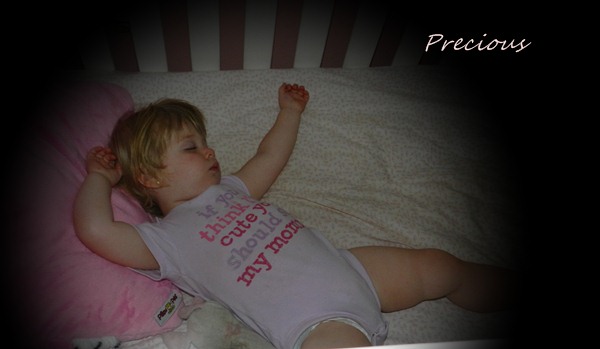Boy oh boy, do I dare even talk about this subject? One, because it’s such a sensitive topic to a lot parents and two, well I happen to have a good sleeper. I know people say I’m lucky, and I do believe I am, however I also believe I worked my butt off to have that good sleeper. It was a tough decision for my husband and I to give up rocking our daughter to sleep because we thought self soothing was more important. It was an even tougher decision as an infant to let our daughter cry at times knowing she had a clean diaper, a full belly and everything else had been checked. The worst decision of all time……was deciding if the cry it out method was for us or not. I totally respect anyone’s decision on this matter because I know it’s a tough one, NO PARENT wants to hear their child cry, for any reason. When we moved our daughter into her crib at 8 weeks old it wasn’t an easy move for either one of us. I was no longer close to her to get up and attend to her every need, I could no longer hear her breathing at all times, the worry just kicked in ten times more at this point, but we knew it was something we wanted to do sooner rather than later, my husband and I were starting to not sleep as good. My mother kept telling me we would sleep better without her in the room, I couldn’t possible imagine that this could be true, but of course she proved herself again, and not for the last time either. I have no regrets. I still rocked my baby, I just didn’t rock her to the actual sleep point, I rocked her until she got “sleepy”. I never let my child cry for more than a few minutes without going in and rubbing her back, calming her down to let her know Mommy was still there. As an infant they don’t “get” the concept of mommy and daddy coming and going. You can say we did the cry it out method, but I still spent at least a week of going in every few minutes for an hour each night before she would settle down, it was even longer process for her to get used to napping in her room. She grew accustomed to napping in her swing or the pack and play so the nap time change was days and days of me doing this until she finally would nap twice a day. It was draining and for a week straight I stayed home and did nothing but go in every few minutes to calm her down, nap time for that week turned into an all day affair. I sat there crying many days wondering if this was what I was supposed to be doing. I even blamed myself when my daughter grew older and became a not so affectionate child, I thought it was my fault, but I’ve come to realize I did what I did because I thought that’s what worked for me and my family. My daughter just turned two and she now cuddles with me in the morning when she first wakes up and for an hour before going to bed……..see I didn’t damage her after all! 🙂
Those weeks may have been so hard for me and my husband, some ending in tears for me, I still have no regrets and I still take credit as to why my daughter is a good sleeper, and has been since then. My sister still babysits and is amazed that she goes to bed so well. Hey other Momma’s could have done this exact same thing and still wound up with a not so good sleeper, I don’t know, but I’ll stick to my theory and let it make me feel good. Like all of those tears were worth it in some way or another. We haven’t faced the crib stage into the toddler bed stage yet so I may change my mind within the next year!!
I know everyone has different thoughts on this topic and to each is own is absolutely right, what works for me might not work for you as a parent or for your child, however here are some tips from the specialists. Ask me again in a few months when I put Madison into a big girl bed, I may be speaking differently! Here is another good article on using the Reward System on getting your child to STAY in bed. Parenting-How I got my child to stay in bed.
How you can establish healthy sleep habits for 12-18 month olds. Typical sleep at this age
Now your baby is officially a toddler – but he still needs as much sleep as he did when he was younger. Until his second birthday, your child should get about 14 hours of sleep a day, 11 of those hours at night. The rest will come in nap form.
Your child will still need two naps at 12 months, but by the time he’s 18 months old, he may be ready for a single hour-and-a-half to three-hour nap in the afternoon – a pattern he may follow until he’s four or five. The transition from two naps to one can be difficult. Sleep expert Jodi Mindell suggests alternating one-nap and two-nap days, depending on how much sleep your toddler got the night before. You can also try putting your child to bed a little earlier on one-nap days.
There’s not much new you can do to help your child become a good sleeper at this age – look for fresh issues such as bedtime resistance to show up sometime between 18 months and your toddler’s third birthday. Your best bet now: Continue practicing the strategies you’ve been developing since your child was 6 months old, including:
Following a nightly bedtime ritual.
A regular bedtime routine will help your child wind down at the end of the day and get ready for sleep. If he needs to work off some excess energy, it’s okay to let him run around for a little while before moving on to something more calming, such as a quiet game, bath, orbedtime story. Follow the same pattern every night – even when you’re away from home. Toddlers love consistency; being able to predict when and how something’s going to happen helps them feel in control.
Stick to a consistent daily schedule, as well as bed- and naptimes.
As always, it’s also a good idea to set and stick to consistent bed- and naptimes as part of your daily schedule. If your child naps, eats, plays, and gets ready for bed at about the same time every day, he’ll be much more likely to fall asleep without a struggle.
Make sure your child is able to fall asleep on his own.
Don’t forget how important it is for your toddler to fall asleep by himself every night. You may want to consider avoiding rocking, nursing, or singing your child to sleep so he’ll learn to settle himself back down when he wakes up at night. Your child waking up and not being able to get himself back to sleep is less than ideal for you, too – if he does wake up, he’ll probably cry for you.
At this age your child may have difficulty falling asleep or wake up frequently at night. The reason behind both problems is probably the developmental milestones he’s reaching, especially walking. Your toddler is so excited by his new skills that he wants to keep practicing, even if you say it’s bedtime.
If he resists going to sleep, most experts advise leaving him in his crib for a few minutes to see whether he’ll calm down. If not, you may want to consider using some version of the”cry it out” approach. You’ll also have to decide what to do if he wakes up at night, can’t soothe himself back to sleep, and ends up crying for you. It’s fine to go in and check on or comfort him. But if he wants you to stay and play with him, gently remind him that nighttime is for sleep.
Esbalishing Healthy Sleep Habits for 18-24 months. Typical sleep at this age
By now your toddler will be sleeping about 11 hours at night and taking a one- to three-hour afternoon nap every day. Some children will hold onto two shorter daily naps until their second birthday. If yours is one of them, don’t fight it.
How you can establish healthy sleep habits
At this age, these are the best things you can do to make sure your child’s sleep habits are on the right track:
Help him break bad sleep habits so he can fall asleep on his own.
Your child should now be drifting off on his own at night without being rocked, nursed, or otherwise lulled to sleep. If he learns to depend on any of these external cues, he won’t be able to fall back to sleep during the night when he wakes up and they’re not there.
Think of it this way, say sleep experts Jodi Mindell and Richard Ferber: You fall asleep with your head on a pillow, only to wake up in the middle of the night and find the pillow gone. You’d probably be concerned about the pillow’s absence and look for it, rousing from your sleepy state.
Similarly, if your child falls asleep every night listening to a particular CD, he’ll wonder what happened when he wakes at night and doesn’t hear the music, and he may not be able to drop off again easily.
To help prevent this, try to get him into bed when he’s sleepy but still awake, so he can fall asleep by himself.
Offer him acceptable choices at bedtime.
These days your toddler is beginning to test the limits of his newfound independence, wanting to assert control over the world around him. To curtail bedtime power struggles, let your child make choices whenever possible during his nighttime routine — from whichbedtime story he wants to hear to which pair of pajamas he’d like to wear.
The trick is to offer only two or three alternatives and to make sure you’re happy with every choice. For example, don’t ask, “Do you want to go to bed now?” He could very well say no, which isn’t acceptable.
Instead, try, “Do you want to go to bed now or in five minutes?” He still gets to make the choice, but you win no matter which option he picks.
Several of the most common sleep problems for toddlers of all ages are difficulty falling asleep, separation anxiety, and frequent night wakings. Children may also experiencenightmares and night terrors.
This age group has its own particular challenge, too: Sometime between 18 and 24 months, some children start climbing out of their crib, potentially putting themselves in danger (falling out of a crib can be pretty painful).
Unfortunately, just because your toddler can get out of his crib doesn’t mean he’s ready for a big bed. Try to keep him safe and stationary with these tips from Sleeping Through the Night, by sleep expert Jodi Mindell:
Lower the mattress: If you move the crib mattress to its lowest position, you may be able to physically prevent your child from getting out. This probably won’t work when he gets bigger, though.
Empty the crib: It’s safest to keep toys, bumpers, and extra bedding out of your toddler’s crib for a variety of reasons anyway, mainly because they’re associated with child injuries like strangulation and entrapment. Your child may also be using crib toys or bumpers as stepstools to help him get out. If you remove them, he may stay put a little longer.
Don’t make jumping out worth his while: If your child jumps out of his crib and you react by giving him lots of attention or letting him get in bed with you, he’ll keep doing it. Instead, stay calm and neutral, firmly tell him not to climb out, and put him right back in his crib. He’ll get the idea pretty quickly.
Keep watch: Nip his escapades in the bud by standing where you can see him in his crib – but he can’t see you. If he tries to get out, immediately tell him not to. After you’ve done this a few times, he’ll probably learn to stay put.
Set up a safe environment: If you can’t keep your child from jumping out, you can at least make sure he stays safe. Place pillows and other padding on the floor around his crib and on nearby toy chests, dressers, and other objects that could cause a hard knock.
If he absolutely won’t stop climbing, you can always move him into his own bed. It may take you a little while to get him to stay, but at least then you won’t have to worry about him falling and hurting himself. If you can’t beat ’em, join ’em.
How you can establish healthy sleep habits for 24-36 months
Now that your child is getting older, you can try a few new techniques to help him get a good night’s sleep, including:
Moving him into a big bed and praising him when he stays in it.
This is the age when your toddler is likely to make the transition from crib to bed, probably because he’ll have outgrown his babyhood digs. The arrival of a new sibling can also prompt the decision. If you’re pregnant, move your toddler at least two to three months before you’re due, advises sleep expert Jodi Mindell. “You want your older child well settled in his new bed before he sees the baby taking over his crib,” says Mindell. But if the switch doesn’t go well, it’s okay to put it off until the new baby is 3 or 4 months old. Your newborn may spend those months sleeping in a bassinet anyway, and your older child will have time to get used to having a sibling, making the crib-to-bed transition easier. Other reasons to consider making the move include frequent jumping out of the crib and toilet training — your child may need to get up at night to go to the bathroom.
Once he’s using his new bed, be sure to praise your child when he stays in it at bedtime and overnight. After the confinement of his crib, your child may get out of his big-kid bed over and over just because he can. If your toddler gets up, temper your reaction. Simply take him back to bed, firmly tell him that it’s time to go to sleep, and leave.
Anticipating all his requests and including them in your bedtime routine.
Your toddler may start trying to put off bedtime by wheedling for “just one more” — story, song, glass of water. Try to anticipate all of your child’s usual (and reasonable) requests and make them part of your bedtime routine. Then, suggests Jodi Mindell, allow your childone extra request — but make it clear that one is the limit. He’ll feel like he’s getting his way, but you’ll know you’re really getting yours.
Giving him an extra goodnight kiss or tuck-in.
It’s okay to promise your child an extra goodnight kiss after you’ve tucked him in the first time. Tell him you’ll be back to check on him in a few minutes. Chances are he’ll be fast asleep by the time you return.
Potential pitfalls
If your toddler starts getting up more often once he graduates to a big bed, tuck him back in and bid him a firm goodnight. Other than that, how to handle the situation is a personal decision. Experts’ opinions vary. Some say: don’t coddle him or bring him into your bed. Some say that as long as your child is falling asleep on his own, it’s fine to go in and soothe him, and others recommend going to your child immediately, finding the source of the problem and comforting him.
Another widespread sleep problem at this age: resistance to bedtime. Ease or avoid the problem by anticipating and managing your child’s before-bed requests. Few toddlers will run happily to bed every night, so be prepared for a few struggles.
You’ll probably notice that your child has some new nighttime worries these days. Being afraid of the dark, monsters under the bed, or separation from you is common in toddlers, so don’t be too concerned. Fears are part of your child’s normal development. If he starts having nightmares, go to him right away and talk to him about his bad dream while you calm him down. If bad dreams persist, look for sources of anxiety in his daily life. Most of the experts agree that if your child is truly terrified, it’s all right to let him into your bed every once in a while, too.










